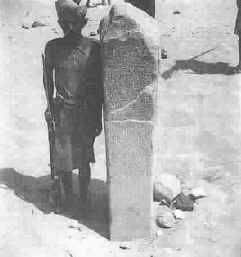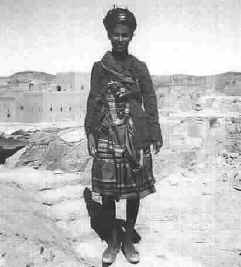| By the
late 1930s, when Europe was confronted with the
probability of another war, the Middle East became an
increasing focus of foreign intrigue as the European
powers competed for influence in the region and
Britain’s access to India was once again under threat.
The impending crisis underlined Aden’s strategic
importance as a naval base and bunkering port (after Italy
joined Germany in June 1940 Aden became the target of
attack by Italian aircraft). Despite the intimations of
war, files of the period available at the Public Records
Office in Kew show that senior officials in Aden continued
to devote time to more parochial concerns (albeit of long
term local importance) such as the assessment, recording
and protection of the antiquities of Aden and its
hinterland.
Sir Bernard Reilly British
Resident in Aden until his appointment as Governor in 1937
(when Aden ceased to be an appendage of British India and
became a Crown Colony), maintained a correspondence with
G.L.M. Clauson, Under-Secretary at the Colonial Office in
London, and with Clauson’s senior assistant, K.W
Blaxter, which clearly demonstrates his personal interest
in the antiquities of the area.
Already in 1931, a small museum
exhibiting a random collection of objects had been opened
by the then Resident in Aden, Sir Stewart Symes. However,
this initiative was to be the subject of a highly critical
report, addressed to Ormsby-Gore (Secretary of State for
the Colonies from 1936-38) by a certain H. Hargreaves of
the Museums Association, following his visit to Aden in
October 1935. Hargreaves’ report caused Reilly and the
museum’s part-time curator, J. Duncan (an employee of A.
Besse & Co. and member of the Aden Settlement Board)
to attempt improvements, but in correspondence with
London, Reilly complained about the lack of funds and
personnel in Aden with archaeological expertise. In
response, Sidney Smith of the Department of Egyptian and
Assyrian Antiquities at the British Museum recommended the
assistance of Professor C. Ryckmans, the eminent
epigraphist at the University of Louvain (who had been
with Philby and Lippens on an expedition in Central
Arabia). Lieutenant-Colonel M.C. Lake, on the other hand,
who served in various military and political capacities in
Aden from 1913-1940, recommended Dr Carl Rathjens, a
German geologist, who had recently excavated a site north
of Sana’a with Von Wissman. Smith’s recommendation was
accepted and Ryckmans visited a number of sites in the
Aden Protectorate in 1937. Stewart Perowne, a government
official, prepared a hand-written representation of the
Himyaritic (sic) alphabet to help Ryckmans decipher
inscriptions. Later, Sidney Smith forwarded to Aden
Ryckmans’ report on three inscriptions from Umm ‘Adiya
— a site on the Audhali plateau, east of Mukeiras, which
had particularly intrigued Perowne.
It is worth noting that towards
the end of 1937 Dr Gertrude Caton-Thompson and Elinor
Gardner, a geologist, accompanied by Freya Stark, began
the first ever systematic excavation in the Protectorate.
This was of the 5th century B.C. Moon Temple of Hureidha
in Wadi ‘Amd (Hadhramaut) and of adjacent tombs.
Ryckmans contributed a chapter to Caton-Thompson’s report which was eventually published
in 1944.
Caton-Thompson’s report which was eventually published
in 1944.
In February 1938, Perowne sent a
photograph of a South Arabian bust (right) to Blaxter at
the Colonial Office, commenting: ‘I was captivated by
the little statue the moment I saw it. It was brought to
me in my tent one morning last May I said that I could
hardly expect to pay anything for a pagan ‘bint’ with
a broken nose and that I was rather offended by being
offered it, but then relented and as a gesture of
compassion I gave the finder 10 rupees for it. It is now
in the Aden museum. The lady’s name has apparently been
recognised by Dr Ryckmans as that of a well-known Southern
Arabian family Miss Caton-Thompson, so Duncan tells me,
thought it the most beautiful statue that had yet come
from Southern Arabia...’ Perowne went on to discuss
Syrian-Greek influence on the region which had first been
noted at Umm ‘Adiya. In a further letter to Blaxter the
following year, Perowne compared the ‘museum bust’ to
the ‘Kaiky beardless man — evidently a statue in the
collection of Kaiky Muncherjee, a Parsee merchant in Aden
who began indulging his interest in antiquities before the
First World War and whose unique collection was ultimately
acquired by the Aden government in the early 1960s.
Much other correspondence took
place in 1938 over photographs of inscriptions and
monuments in Beihan. In July Blaxter wrote to the Hon.
R.A.B. Hamilton (later Lord Belhaven) about ground
photographs of certain ancient sites taken by Flight
Officer Currie, RAF, which the Colonial Office had
recently forwarded to the British Museum. Meanwhile,
Sidney Smith (of the Museum’s Egyptian and Assyrian
Department) complained to Clauson (Under-Secretary at the
Colonial Office) of Hamilton’s perversity in treating
certain antiquities which he had found at Shabwa as his
private property. However, Smith later informed Clauson
that these had, in fact, been given to Lord Raglan (a man
of antiquarian interests and closely associated in later
years with the National Museum of Wales, who was married
to Hamilton’s sister, Julia). In 1952 the antiquities
were presented to the Ashmolean Museum and in 1954 WL.
Brown and A.F.L. Beeston published a paper on them (Sculptures
and Inscriptions of Shabwa) in the Journal of the
Royal Asiatic Society. It is clear from a letter which
Blaxter wrote to Reilly in March 1939 about a discussion
which he and Clauson had had in London with Duncan
(visiting from Aden), that other objects which Hamilton
found at Shabwa were sent to the Aden museum.
Meanwhile, Reilly proposed to
Clauson that an expert should be sent out to Aden to look
at Saber, a 30-acre site covered in potsherds near Imad (a
few miles south of Lahej) which Perowne had investigated,
and to assess the archaeological potential of several
other sites. Clauson approached L.P (later Sir Lawrence)
Kirwan, a friend with whom Clauson had once been on a dig
at Richborough and who was then working in east Sudan and
Ethiopia, to invite him to undertake the survey requested
by Reilly In October 1938 Kirwan accepted, proposing that
he should travel to Aden from Port Sudan the following
March and spend a few days in Aden before visiting sites
inland which, he said, he would examine ‘from the
standpoint of a future excavator’. Kirwan added that his
mission would be greatly facilitated if the RAF could fly
him to Aden and to the sites which he was due to survey Accordingly Blaxter wrote to a Wing Commander Russell
requesting that Kirwan, ‘a distinguished
archaeologist’, be assisted in this way The RAF agreed
and Kirwan arrived inAden on 23 March 1939. In due course
he was flown to Mukeiras, staying with the young Audhali
ruler at Aryab and then visiting the site of Umm ‘Adiya
on the Audhali plateau. He next drove north into Wadi
Beihan, pausing at Beihan al-Qasab, capital of the State
of Beihan, before proceeding to Timna (right), situated on
the mound known locally as Hajar al-Kohian. Returning to
Aden, he visited Saber and other sites between the coast
and Lahej. The photographs which he took during these
visits, both of sites and of the local inhabitants, not
least the dashing young Audhali Sultan, Salih bin Hussain
(below), are a fascinating record of those times.
Accordingly Blaxter wrote to a Wing Commander Russell
requesting that Kirwan, ‘a distinguished
archaeologist’, be assisted in this way The RAF agreed
and Kirwan arrived inAden on 23 March 1939. In due course
he was flown to Mukeiras, staying with the young Audhali
ruler at Aryab and then visiting the site of Umm ‘Adiya
on the Audhali plateau. He next drove north into Wadi
Beihan, pausing at Beihan al-Qasab, capital of the State
of Beihan, before proceeding to Timna (right), situated on
the mound known locally as Hajar al-Kohian. Returning to
Aden, he visited Saber and other sites between the coast
and Lahej. The photographs which he took during these
visits, both of sites and of the local inhabitants, not
least the dashing young Audhali Sultan, Salih bin Hussain
(below), are a fascinating record of those times.
On 20 April 1939, shortly before
joining the army on attachment to the Intelligence Corps,
Kirwan sent Clauson a copy of his report to the Political
Secretary in Aden. This made important recommendations for
the terms governing archaeological excavation and for the
protection of sites from looting. Kirwan also made proposals for improving the
museum, in particular for the more prominent display of
the ‘remarkable female portrait head showing strong
Hellenistic influence’ and of objects from excavations,
notably those unearthed by Hamilton at Shabwa. Kirwan
deplored the fact that the ‘interesting collection of
antiquities belonging to Mr Kaiky Muncherjee remained in
private hands’, but he was not to know that within
little more than twenty years the collection would become
part of the Aden museum. Kirwan also expressed the view
that antiquities collected by the government should remain
in Aden and not be sent to England. In parallel with
Kirwan’s recommendations, the Society of Antiquaries
made a public appeal for the protection of monuments and
antiquities in Aden. The outcome of these developments was
the drafting and passage of the Antiquities Ordinance of
1939 which, for the first time, established a legal
framework for archaeological activity and the protection
of the country’s heritage. The Ordinance was to remain
in force until superseded in 1962 by the establishment of
a Department of Antiquities under Brian Doe as its first
Director.
looting. Kirwan also made proposals for improving the
museum, in particular for the more prominent display of
the ‘remarkable female portrait head showing strong
Hellenistic influence’ and of objects from excavations,
notably those unearthed by Hamilton at Shabwa. Kirwan
deplored the fact that the ‘interesting collection of
antiquities belonging to Mr Kaiky Muncherjee remained in
private hands’, but he was not to know that within
little more than twenty years the collection would become
part of the Aden museum. Kirwan also expressed the view
that antiquities collected by the government should remain
in Aden and not be sent to England. In parallel with
Kirwan’s recommendations, the Society of Antiquaries
made a public appeal for the protection of monuments and
antiquities in Aden. The outcome of these developments was
the drafting and passage of the Antiquities Ordinance of
1939 which, for the first time, established a legal
framework for archaeological activity and the protection
of the country’s heritage. The Ordinance was to remain
in force until superseded in 1962 by the establishment of
a Department of Antiquities under Brian Doe as its first
Director.
November 1998
|
